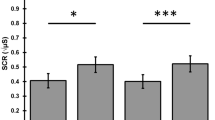Abstract
Most investigations of information processing in human Pavlovian autonomic conditioning focussed on the role of awareness of the contingency of the conditioned stimulus (CS) and the unconditioned stimulus (UCS). While in these studies only the qualitative information of the CS (UCS occurring vs not occurring) was varied, the present experiment was designed to vary the quantitative information of the CS. In a differential conditioning paradigm, using a letter reproduction task as nonaversive UCS, electrodermal responses to different degrees of CS information content were investigated. Twenty subjects experienced two different conditions in a within subject design. In one condition only the number of letters used in the following UCS was presented as CS+, while in the other condition the CS already contained the whole UCS information. Both conditions led to significant differences in magnitudes of electrodermal responding.
Similar content being viewed by others
References
Boucsein, W. (in press).Electodermal activity. New York: Plenum Press.
Dawson, M.E., & Schell, A.M. (1985). Information processing and human autonomic classical conditioning. In P.K. Ackles, J.R. Jennings, & M.G.H. Coles (Eds.),Advances in psychophysiology (Vol. 1, pp. 89–165). Greenwich, CT: JAI Press.
Greenhouse, S.W., & Geisser, S. (1959). On methods in the analysis of profile data.Psychometrika, 24, 95–112.
Lipp, O.V., & Vaitl, D. (1988). Reaction time task as unconditional stimulus: On conditioning skin conductance responses and heart rate, using a nonaversive unconditional stimulus.Pavlovian Journal of Biological Science, 23, 165–172.
Lipp, O.V., & Vaitl, D. (1990). Reaction time task as unconditional stimulus.Pavlovian Journal of Biological Science, 25, 77–83.
Öhman, A. (1979). The orienting response, attention and learning: An information-processing perspective. In H.D. Kimmel, E.H. van Olst, & J.F. Orlebecke (Eds.),The orienting reflex in humans (pp. 443–471). Hillsdale, N.J.: Lawrence Erlbaum Associates.
Prokasy, W.F., & Ebel, H.C. (1967). Three components of the classically conditioned GSR in human subjects.Journal of Experimental Psychology, 73, 247–256.
Spinks, J.A., Blowers, G.H., & Shek, D.T.L. (1985). The role of orienting response in the anticipation of information: A skin conductance response study.Psychophysiology, 22, 385–394.
Author information
Authors and Affiliations
Corresponding author
Rights and permissions
About this article
Cite this article
Kirsch, P., Boucsein, W. & Baltissen, R. Electrodermal activity as an indicator of information processing in a nonaversive differential classical conditioning paradigm. Integrative Physiological and Behavioral Science 28, 154–157 (1993). https://doi.org/10.1007/BF02691219
Issue Date:
DOI: https://doi.org/10.1007/BF02691219




